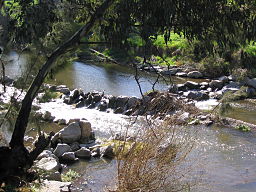Cockburn River
| Cockburn River | |
| Perennial river | |
|
A rock-chute, on the Cockburn River, near Tamworth
|
|
| Name origin: In honour of George Cockburn | |
| Country | Australia |
|---|---|
| State | New South Wales |
| Region | IBRA: New England Tablelands |
| District | Northern Tablelands |
| Municipality | Tamworth |
| Tributaries | |
| - left | Mulla Mulla Creek, Swamp Oak Creek |
| - right | Jamiesons Creek, Moonbi Creek |
| Source | Moonbi Range |
| - location | near Limbri |
| - elevation | 493 m (1,617 ft) |
| Mouth | confluence with the Peel River |
| - location | west of Nemingha |
| - elevation | 384 m (1,260 ft) |
| Length | 33.6 km (21 mi) |
Cockburn River /ˈkoʊbərn/, a perennial river that is part of the Namoi catchment within the Murray–Darling basin, is located in the Northern Tablelands district of New South Wales, Australia.
The river rises in the west slopes of Moonbi Range, near Limbri and then flows generally west south west, joined by four minor tributaries, towards its confluence with the Peel River at Nemingha; dropping 109 metres (358 ft) over its course of 33 kilometres (21 mi).
The river was first encountered by European explorers on 4 September 1818 during an expedition led by the Surveyor-General of New South Wales, John Oxley, who named the river in honour of Admiral Sir George Cockburn.
From upstream to downstream, the Cockburn River flows through or near the localities of Limbri, Moonbi, Kootingal, Tintinhull and Nemingha. A section of the Main North railway line runs along the valley of the Cockburn River.
...
Wikipedia

